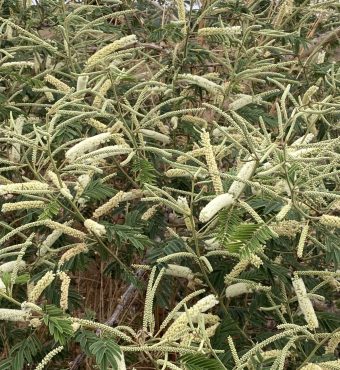


Botanical Name: Acacia Polycantha Willd.
Synonym: Acacia campylacantha Hochst. Ex A. Rich.
Common Name: White Stem Acacia
Plant Family: Mimosoideae
Origin: Africa
References: Coates Palgrave p.294, Timberlake et.al. p.102-103, Dharani p.134-137. S.A. No. 180, Zimb. No. 219
Description: Medium to large deciduous tree with flaky, grey corky bark often with thorned bosses. Thorns small and hooked. Bipinnate leaves up to 20cm long with 20-60 pairs of fine (2-5mm) grey-green leaflets. Flower a 12cm creamy white spike appearing with new leaves. The fruit thin, straight, flat brown pod (8-18cm) and dehiscent (splitting).
Features of Particular Interest: Tree shape and distinctive foliage.
Height and Spread: 10m – 20m high, 5m – 8m spread.
Periods of Interest:
Leaf: September to May.
Flowering: September to December.
Fruiting: March to June.
Bark: All year round.
Cultivation
Soil and Moisture: Acacia polyacantha occurs in a variety of soils. Plant in full sun or semi shade and water regularly. It is drought resistant.
Aspect: Grows well in exposed situations.
Hardiness: Hardy once established.
Maintenance and Pruning: Not required unless taking fire wood.
Propagation: Acacia polyacantha is relatively easy to germinate. The seed should be planted with a light sand/soil cover and watered regularly. Transplant into larger bags when several leaves have emerged.
Problems and Drawbacks: Roots not known to be intrusive, but it will lose its leaves and seed pods in winter, so do not plant near swimming pools.
Use and Associated Planting: Fast growing and is a useful quick fix. Consequently often used as a woodlot tree and to re-colonise bare ground. Also used a nursery tree for slower growing trees and can be removed when slower growers are established.
